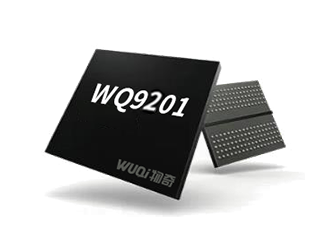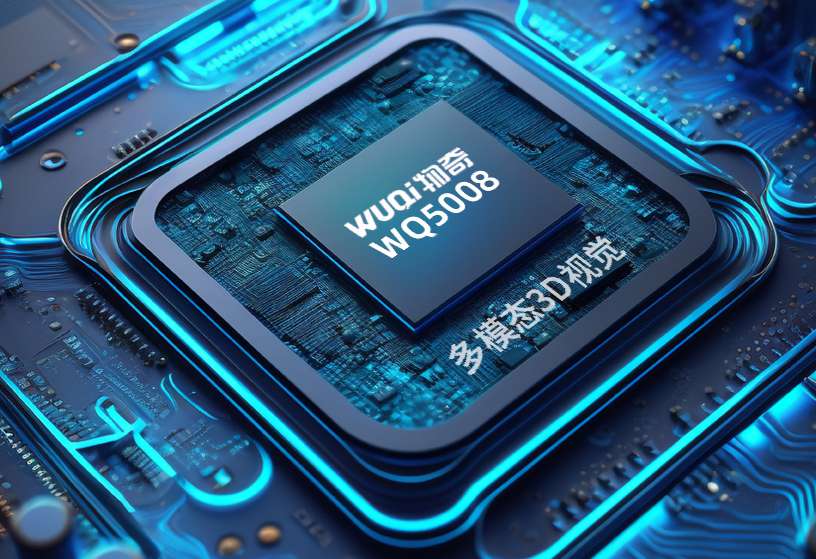As a new technology with the highest market penetration rate, Wi-Fi 6 features in higher speed, larger capacity and lower latency, providing wireless connection services for billions of terminals and driving the high-end Wi-Fi chip market in to dramatic rise.
As a leading short-range communication SoC designer in China, WUQI has been focusing on the R&D of high-end Wi-Fi chips for three years, and has successfully launched China's first 1x1 dual-band dual-concurrent (DBDC) Wi-Fi 6 chip (WQ9101) and put it in mass production.
WQ9101 is a DBDC Wi-Fi 6 SoC chip that supports IEEE802.11ax and is backward compatible with IEEE802.11 a/b/g/n/ac protocols. With four high-performance RISC-V CPUs and the 2.4 GHz/5 GHz dual-band architecture, WQ9101 supports multiple high-speed interfaces and various peripheral interfaces, and is of industry-leading RF and baseband performance. Currently, WQ9101 is widely applied to consumer electronics such as the TV, tablet, PC, and smart speaker, and WUQI has reached in-depth cooperation with leading brands regarding this chip.
WQ9101 has the following features:
· Integrates functions of both Wi-Fi 6 and BT 5.3, and is compatible with IEEE 802.11 a/b/g/n/ac/ax, BT5.3 and BLE audio protocols. Supports both on-chip and off-chip coexistence of Wi-Fi and Bluetooth.
· Embedded with four optimum-performance RISC-V CPUs, and supports high-speed interfaces such as SDIO3.0 and USB2.0 and various peripheral interfaces like the UART, SPI, and I2S.
· Adopts OFDMA and the latest MU-MIMO technology to support parallel transmission by multiple terminals, effectively increasing the data rate and reducing the latency, as well as ensuring premium user experience in terms of device access.
· Supports DBDC in 2.4 GHz and 5 GHz. Supports a maximum of 80 MHz bandwidth, 1024QAM, and physical layer rate 900 Mbps.
· Supports superb-performance DC modes of STA+AP, STA + P2P GO, and STA + P2P GC based on WUQI's DBDC RF architecture.
With its self-developed technologies regarding the baseband, communication algorithms and analog RF circuits, WUQI entered the promising Wi-Fi market as early as the beginning of 2019, and successfully realized mass production of the first Wi-Fi 4 chip in 2021. WUQI's first Wi-Fi chip was in competitive quality and favored by many well-known brands including TP-Link upon its release, and was quickly put in to mass production.
With ceaseless efforts made in the Wi-Fi field, WUQI has been developing high-end Wi-Fi 6/7 products. Following the R&D cycle of "Pre-research, design, mass production and marketing", engineers and experts in WUQI makes continuous progress in RF/analog, system/algorithm and SoC, successively putting new products in to commercial use, acquiring knowledge on new technologies, and implementing pre-research on new products to seize market opportunities.
In subsequent to the mass-produced high-end DBDC Wi-Fi 6 chip, the Wi-Fi 6 AP designed for high-speed data transmission is going to be taped out next year, and high-end chips including the next-generation Wi-Fi 6E and Wi-Fi 7 are being designed and pre-researched, respectively. All these efforts ensure continuous evolution of new products, shorten the iterative process, and raise the market penetration rate of Wi-Fi chips.
The evolution of new technologies greatly expands wireless application scenarios, creates a huge incremental market, and offers many domestic high-end Wi-Fi 6/7 chip designers with unprecedented market opportunities. Meanwhile, the competition of the chip market is getting even fiercer.
According to a research report published by Sinolink Securities in 2022, the shipments of domestic Wi-Fi chips will increase from 0.43 billion in 2018 to 1.03 billion in 2025, with an average compound annual growth rate of 13.3%. The majority of Wi-Fi chips are applicable to IoT in 2.4 GHz only in the early stage. The shipments of high-end Wi-Fi 6/7 chips will increase from 45 million in 2019 to 770 million in 2025, accounting for about 80% of China’s high-end Wi-Fi chips at that time. In addition, the estimated market size will exceed 20.9 billion yuan by then.




















